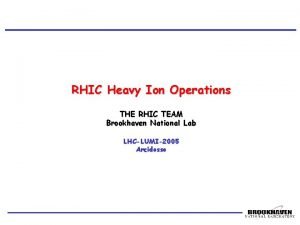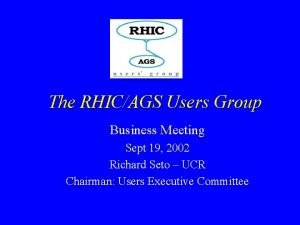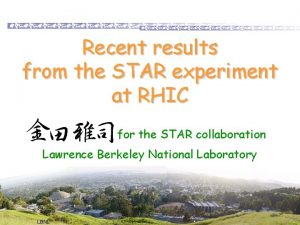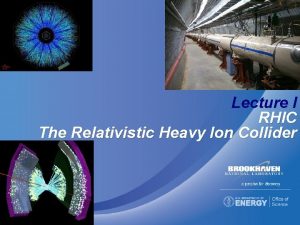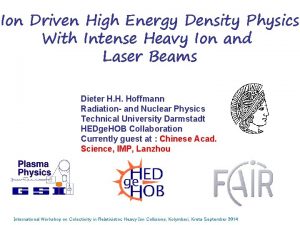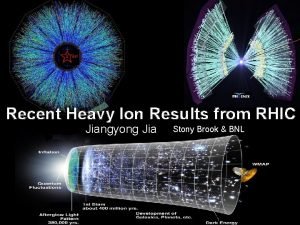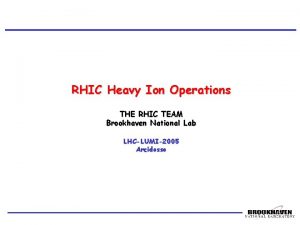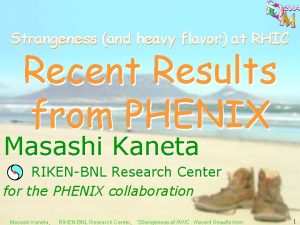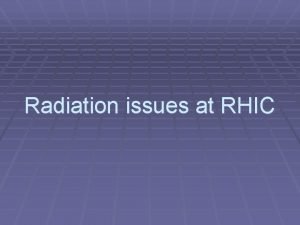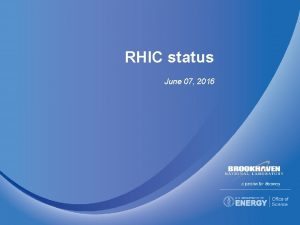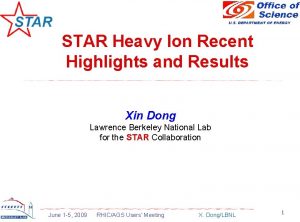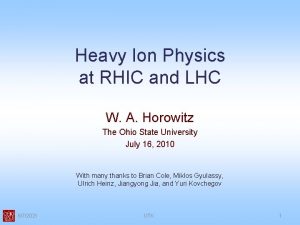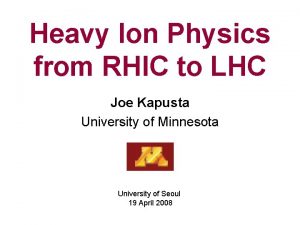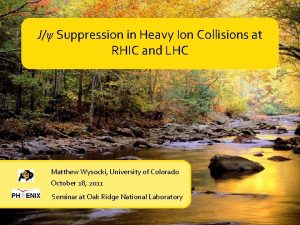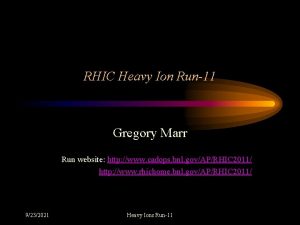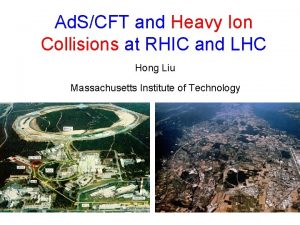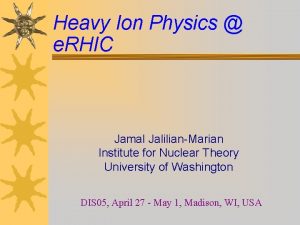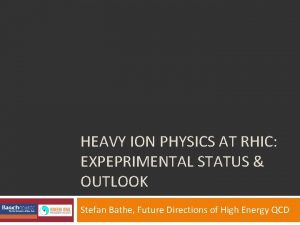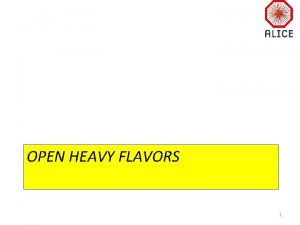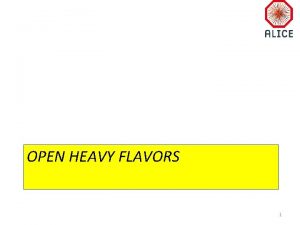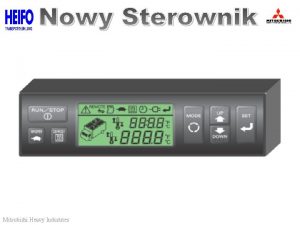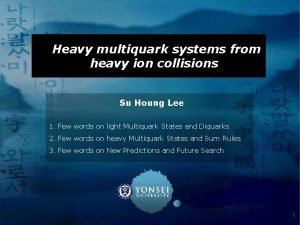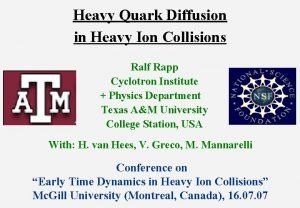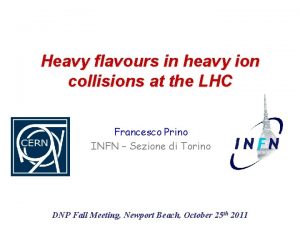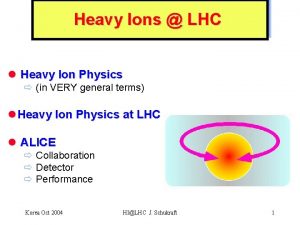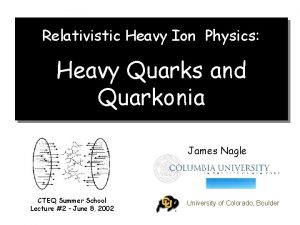Recent Results from the RHIC Heavy Ion Program























































- Slides: 55

Recent Results from the RHIC Heavy Ion Program Xiaochun He Department of Physics and Astronomy Georgia State University 12/2/2010 MPI@LHC, 2010 1

Outline • Motivation and RHIC History • Highlights of the Recent RHIC Results: Temperature Measurement of the Hot QCD Medium • Outlook 12/2/2010 MPI@LHC, 2010 2

Motivations • It is probably the only venue to study the properties of the high temperature and density QCD matter experimentally in a controlled laboratory – explore the QCD matter phase space. • It also provides a laboratory-based test of the standard model of cosmology. 12/2/2010 MPI@LHC, 2010 3

Phase Diagram (H 2 O) – We Have Done This! A fundamental understanding requires the knowledge of i) The location of the Critical End Point (CEP) ii) The location of phase coexistence lines iii) The properties of each phase http: //www. btinternet. com/~martin. chaplin/phase. html This knowledge is fundamental to the phase diagram of any substance ! 12/2/2010 MPI@LHC, 2010 4

Explore QCD Phase Space • The colliding nuclei at RHIC energies would melt from protons and neutrons into a collection of quarks and gluons LHC experiments Quark Gluon Plasma Hadron Tc ~ 170 Me. V; e ~ 1. 5 Ge. V/fm 3 Measure the initial temperature of matter formed at RHIC Is Tinit higher than Tc ~ 170 Me. V? 12/2/2010 MPI@LHC, 2010 5

t z/ /c -z t= t= “Thermalized” partonic Fluid! (s)QGP? c Particle ratio measurements Flow measurements Multiplicity measurements A “little Bang” occurs in RHIC collisions e. Bjorken ~ 5 - 15 Ge. V/fm 3 0 z: collision axis ~ 35 – 100 ε 0 Emerging Picture 12/2/2010 x Gold v~0. 99 c nucleus MPI@LHC, 2010 Gold nucleus 6

Recreate the Matter State of the Early Universe • Our expanding universe must have started out much hotter and denser than it is today because the expansion caused matter and energy to cool down and spread out with time. • As the universe cooled down, it may have undergone a brief period of very rapid expansion known as inflation that could account for several key properties of today’s universe. • Temperatures shortly after the Big Bang were so hot that photons could change into elementary particles and vice versa. The early universe was therefore filled with photons and all kinds of elementary particles. • After an age of 0. 001 second, the universe became too cool to produce protons and antiprotons from pure energy. These particles then annihilated, leaving only a small fraction of the original protons left over. • Up until 5 minutes after the Big Bang, the universe was still hot enough to fuse hydrogen into helium. The observed amount of helium in the universe agrees with predictions of the Big Bang theory. 12/2/2010 MPI@LHC, 2010 7

RHIC Birdview PHOBOS BRAHMS PHENIX STAR 12/2/2010 MPI@LHC, 2010 8

12/2/2010 MPI@LHC, 2010 9

RHIC Run Summary 12/2/2010 MPI@LHC, 2010 10

BRIEF HIGHLIGHTS 12/2/2010 MPI@LHC, 2010 11

RHIC White Papers SPIRES Citation Report as of Nov. 30, 2010: 739 12/2/2010 758 971 MPI@LHC, 2010 979 12

What We Set Out to Measure? Theorists predicted a number of signals that might abruptly manifest themselves as soon as we crossed the critical Temp. & density for the phase transition Change in mass, width of f meson More particles containing the heavy charm quark 12/2/2010 Disappearance of J/y Change in pion charged/neutral Increase in # of photons @ low momentum MPI@LHC, 2010 13

How Did We Do on the Predictions? Theorists predicted a number of signals that might abruptly manifest themselves as soon as we crossed the critical Temp. & density for the phase transition X Change in mass, width of f meson ? X Disappearance of J/y X More particles containing the heavy charm quark 12/2/2010 Change in pion charged/neutral ? Increase in # of photons @ low momentum MPI@LHC, 2010 14

Reaction Plane and Elliptic Flow Py Pz Px Elliptic Flow Momentum anisotropy Spatial anisotropy Fourier expansion of the distribution of produced particle angle wrt reaction plane (Df): • Momentum anisotropy reflects the characteristics of the hot, dense medium – Small mean free path, thermalization, pressure gradients • v 2 long considered a powerful probe for QGP studies 12/2/2010 MPI@LHC, 2010 15

A Classic Result: v 2 PRL 91, 182301 (2003) • Large v 2 has been observed at RHIC • v 2 at low p. T (~1. 5 Ge. V/c) predicted by hydrodynamical models • Results suggest early thermalization (~0. 6 fm/c) and quark flow PRL. 98, 162301 (2007) Au+Au, s. NN = 200 Ge. V 12/2/2010 MPI@LHC, 2010 16

The matter is so opaque that even a 20 Ge. V p 0 is stopped. PRL 101, 232301 (2008) PHENIX: PRC 82, 011902 (2010) • Suppression is very strong (RAA=0. 2!) and flat up to 20 Ge. V/c • Common suppression for p 0 and h; it is at partonic level • e > 15 Ge. V/fm 3; d. Ng/dy > 1100 12/2/2010 MPI@LHC, 2010 17

High-p. T: Domain of hard-scattering Phys. Rev. C 77, 064907 (2008) High-p. T suppression • Jets are quenched – But what are the details of the quenching? • RP to the “rescue” – Centrality studies help to constrain the geometry – Angle with respect to RP: fix the path length! 12/2/2010 MPI@LHC, 2010 18

The matter is so dense that even heavy quarks are stopped PHENIX: PRL 98, 172301 (2007) Even heavy quark (charm) suffers substantial energy loss in the matter (1) q_hat = 0 Ge. V 2/fm (4) d. Ng / dy = 1000 (2) q_hat = 4 Ge. V 2/fm (3) q_hat = 14 Ge. V 2/fm 12/2/2010 MPI@LHC, 2010 The data provide a strong constraint on the energy loss models. The data suggest large cquark-medium cross section; evidence for strongly coupled QGP. 19

The matter is so strongly coupled that even heavy quarks flow PHENIX: PRL 98, 172301 (2007) Greco, Ko, Rapp: PLB 595(2004)202 v 2(D)=v 2(p) v 2(D)=0. 6 v 2(p) v 2(D)=0. 3 v 2(p) 12/2/2010 • Charm flows, but not as strong as light mesons. • Drop of the flow strength at high p. T. Is this due to bquark contribution? • The data favors the model that charm quark itself flows at low p. T. • Charm flow supports high parton density and strong coupling in the matter. It is not a weakly coupled gas. MPI@LHC, 2010 20

The matter is so hot that it emits (thermal? ) photon copiously • The first promising result of direct photon measurement at low p. T from low-mass electron pair analysis. • Are these thermal photons? The rate is above p. QCD calculation. The method can be used in p+p collisions. • If it is due to thermal radiation, the data can provide the first direct measurement of the initial temperature of the matter. • What is the temperature? 12/2/2010 MPI@LHC, 2010 21

The matter is so dense that it melts(? ) J/y (and regenerates it ? ) d. Au mm 200 Ge. V/c Au. Au mm 200 Ge. V/c Cu. Cu mm 200 Ge. V/c Au. Au ee 200 Ge. V/c Cu. Cu ee 200 Ge. V/c PHENIX PRL 98 (2007) 232301 12/2/2010 MPI@LHC, 2010 - Suppression is substantially stronger at y=1. 7 than at y=0. - Not expected if suppression increases with energy density. - There have been attempts to explain this as being due to coalescence of charm pairs in the medium, or at hadronization. - But SPS (17. 3 Ge. V!) Pb+Pb J/ψ data show comparable suppression at y~0. 5 to PHENIX at y~ 0. 22

The matter is so dense that it modifies the shape of jets • The shapes of jets are modified by the matter. – Mach cone? – Cerenkov? • Can the properties of the matter be measured from the shape? – Sound velocity – Di-electric constant PHYSICAL REVIEW C 78, 014901 (2008) PHENIX preliminary 12/2/2010 MPI@LHC, 2010 • Di-jet tomography is a powerful tool to probe the matter 23

Put the Results Together The matter is dense e > 15 Ge. V/fm 3 d. Ng/dy > 1100 Tave = 300 - 400 Me. V (? ) Vs = ? e(dielec) = ? The matter is strongly coupled Temperature? PHENIX preliminary The matter modifies jets The matter may melt but regenerate J/y’s 12/2/2010 The matter is hot MPI@LHC, 2010 24

Phys. Rev. Lett. 104, 132301 (2010) "Enhanced production of direct photons in Au+Au collisions at sqrt(s_NN)=200 Ge. V and implications for the initial temperature" TEMPERATURE MEASUREMENT 12/2/2010 MPI@LHC, 2010 25

Temperature is an Important Physical Variable in the Standard Model in Cosmology http: //pdg. lbl. gov For N = 52, T = 250 Me. V, one has t = 5. 3 x 10 -6 s, T = 2. 9 x 1012 K, r = 8. 9 Ge. V/fm 3. 12/2/2010 MPI@LHC, 2010 26

Remote Temperature Sensing Red Hot White Hot • Hot Objects produce thermal spectrum of EM radiation. • Red clothes are NOT red hot, reflected light is not thermal. Photon measurements must distinguish thermal radiation from other sources: HADRONS!!! 12/2/2010 MPI@LHC, 2010 Not Red Hot! 27

Thermal photon from hot matter Hot matter emits thermal radiation Temperature can be measured from the emission spectrum 12/2/2010 MPI@LHC, 2010 28

Photon Probe of Nuclear Collisions Time time g p f p K g p K p freeze-out ex Hadron Gas on si n pa quark-gluon plasma Photons can probe the early stage of the reaction deep inside of the dense matter hard parton scattering Au 12/2/2010 MPI@LHC, 2010 Space Au 29

Many sources of photons quark gluon g p. QCD direct photons from initial hard scattering of quarks and gluons Thermal photons from hot quark gluon plasma p p r g p 12/2/2010 g g Thermal photons from hadron gas after hadronization background Decay Photons from hadrons (p 0, h, etc) MPI@LHC, 2010 30

Thermal photons (theory prediction) p p r g Hadron decay photons g q q g • High p. T (p. T>3 Ge. V/c) p. QCD photon • Low p. T (p. T<1 Ge. V/c) photons from hadronic Gas • Themal photons from QGP is the dominant source of direct photons for 1<p. T<3 Ge. V/c • Recently, other sources, such as jet-medium interaction are discussed • Measurement is difficult since the expected signal is only 1/10 of photons from hadron decays S. Turbide et al PRC 69 014903 12/2/2010 MPI@LHC, 2010 31

Direct Photons in Au+Au Blue line: Ncoll scaled p+p cross-section Direct photon is measured as “excess” above hadron decay photons Measurement below p. T<3 Ge. V/c is difficult since the yield of thermal photons is only 1/10 of that of hadron decay photons PRL 94, 232301 (2005) Au+Au data consistent with p. QCD calculation scaled by Ncoll MPI@LHC, 2010 12/2/2010 32

Alternative method - measure virtual photons ee+ • Source of real photon should also be able to emit virtual photon • At m 0, the yield of virtual photons is the same as real photon Real photon yield can be measured from virtual photon yield, which is observed as low mass e+e- pairs • Advantage: hadron decay background can be substantially reduced. For m>mp, p 0 decay photons (~80% of background) are removed S/B is improved by a factor of five • Other advantages: photon ID, energy resolution, etc • Cost: the yield is reduced by a large factor (~ a/3 p ~ 1/1000) 12/2/2010 MPI@LHC, 2010 33

Virtual Photon Measurement Any source of real g can emit g* with very low mass. Relation between the g* yield and real photon yield is known. Process dependent factor p Case of hadrons (p 0, h) (Kroll-Wada) Direct g p 0 12/2/2010 h S = 0 at Mee > Mhadron p Case of direct g* If p. T 2>>Mee 2 S = 1 p For m>mp, p 0 background (~80% of background) is removed S/B is improved by a factor of five MPI@LHC, 2010 34

Not a new idea J. H. Cobb, C. Albajar, etetal, PL PLB 209, 78 B, 519 397 (1978) (1988) g/p 0 = 10% Dalitz g/p 0 = 0. 53 ± 0. 92% (2< p. T < 3 Ge. V/c) 12/2/2010 • The idea of measuring direct photon via low mass lepton pair is not new one. It is as old as the concept of direct photon. • This method is first tried at CERN ISR in search for direct photon in p+p at s 1/2=55 Ge. V. They measured e+e- pairs for 200<m<500 Me. V, and set one of the most stringent limit on direct photon production at low p. T • Later, UA 1 measured low mass muon pairs and deduced the direct photon cross section. MPI@LHC, 2010 35

e+e- mass spectra in p. T slices p+p Au+Au A. Adare et al. Phys. Rev. C 81, 034911 (2010) • p+p in agreement with cocktail • Au+Au low mass enhancement concentrated at low p. T 12/2/2010 MPI@LHC, 2010 36

Enhancement of almost real photon A. Adare et al. , PRL 104, 132301 (2010) pp Au+Au (MB) Mp 12/2/2010 Mp 1 < p. T < 2 Ge. V 2 < p. T < 3 Ge. V 3 < p. T < 4 Ge. V 4 < p. T < 5 Ge. V MPI@LHC, 2010 Low mass e+e- pairs (m<300 Me. V) for 1<p. T<5 Ge. V/c p+p: • Good agreement with hadronic decay cocktail • Small excess above mp due to p. QCD direct g at high p. T Au+Au: • Clear enhancement visible above mp =135 Me. V for all p. T 37

Determination of g* fraction, r Direct g*/inclusive g* is determined by fitting the following function r = direct g*/inclusive g* fdirect : direct photon shape with S = 1. • Fit in 120 -300 Me. V/c 2 (insensitive to p 0 yield) • The mass spectrum follows the expectation for m > 300 Me. V S(m) ~ 1 A. Adare et al. , PRL 104, 132301 (2010) 12/2/2010 MPI@LHC, 2010 38

Fraction of direct photons A. Adare et al. , PRL 104, 132301 (2010) p+p Au+Au (MB) NLO p. QCD μ = 0. 5 p. T μ = 1. 0 p. T μ = 2. 0 p. T • Fraction of direct photons • Compared to direct photons from p. QCD p+p • Consistent with NLO p. QCD Au+Au • Clear excess above p. QCD NLO p. QCD calculation by Werner Vogelsang 12/2/2010 MPI@LHC, 2010 39

Direct photon spectra exp + TAA scaled pp A. Adare et al. , PRL 104, 132301 (2010) • Direct photon measurements – real (p. T>4 Ge. V) – virtual (1<p. T<5 Ge. V) • p. QCD consistent with p+p down to p. T=1 Ge. V/c • Au+Au data are above Ncoll scaled p+p for p. T < 2. 5 Ge. V/c • Au+Au = scaled p+p + exp: TAu. Au = 221 19 stat 19 syst Me. V Fit to pp NLO p. QCD (W. Vogelsang) 12/2/2010 • Theoretical prediction of thermal photon by Turbide et al. agrees with the data within about a factor of two. MPI@LHC, 2010 40

Theory Comparison • Hydrodynamical models are compared with the data D. d’Enterria &D. Peressounko T=590 Me. V, t 0=0. 15 fm/c S. Rasanen et al. T=580 Me. V, t 0=0. 17 fm/c D. K. Srivastava T=450 -600 Me. V, t 0=0. 2 fm/c S. Turbide et al. T=370 Me. V, t 0=0. 33 fm/c J. Alam et al. T=300 Me. V, t 0=0. 5 fm/c F. M. Liu et al. T=370 Me. V, t 0=0. 6 fm/c A. Adare et al. Phys. Rev. C 81, 034911 (2010) 12/2/2010 MPI@LHC, 2010 Hydrodynamical models agree with the data within a factor of ~2 41

Initial temperature A. Adare et al. ar. Xiv: 0912. 0244 TAu. Au(fit) ~ 220 Me. V TC from Lattice QCD ~ 170 Me. V From data: Tini > TAu. Au ~ 220 Me. V From models: Tini = 300 to 600 Me. V for t 0 = 0. 15 to 0. 6 fm/c Lattice QCD predicts a phase transition to quark gluon plasma at Tc ~ 170 Me. V 12/2/2010 MPI@LHC, 2010 42

“free” Gas On the Map of the Phase Space We are here 500 Plasma “free” Gas 300 200 “Perfect” Liquid T (Me. V) 400 “Perfect” Liquid Quark Gluon Plasma Hadrons 100 Tc ~ 170 Me. V; e ~ 1 Ge. V/fm 3 At these temperature, QGP is “perfect” liquid. At higher temperature, it can become “gas” 12/2/2010 MPI@LHC, 2010 43

Summary • The matter created in Au+Au collisions at per nucleon-nucleon cms energy of 200 Ge. V is dense. Quarks (both the light and the heavy) and gluons experience large energy loss while traversing this medium. • The system is rapidly thermalized from the measurement of elliptic flow of light and charmed hadrons. The quark number scaling of the flow (v 2) indicates the partonic nature of thermalized medium. • Such a hot and dense medium emits thermal radiation. The observation of thermal photons allows the determination of the initial temperature of the matter! 12/2/2010 MPI@LHC, 2010 44

Outlook • Both experiments (PHENIX and STAR) at RHIC are developing a concrete decadal plan for further characterizing the high temperature QCD matter created from colliding heavy ions. • LHC heavy ion program just had a great start by colliding Pb+Pb at 2. 76 Te. V which is a factor of 14 higher in energy over RHIC. We are expecting that results from the new measurements will soon flood the field. • We are entering an exciting new era of high energy heavy ion physics program which, we hope, allows us to have a better understanding the QCD matter at extreme conditions. 12/2/2010 MPI@LHC, 2010 45

The dust isn’t likely to settle soon! The end THANKS 12/2/2010 MPI@LHC, 2010 46

Basics of Heavy Ion Collisions at RHIC z y x Central 12/2/2010 Peripheral MPI@LHC, 2010 47

The PHENIX Experiment Tale of the Tape: ØBegun Operation June 2000 Ø 550 Scientists, 14 Countries, 69 Inst. Ø 18 Detector subsystems Ø 4 Spectrometer arms ØLarge electromagnets ØTotal weigh = 3500 Tons Ø>300, 000 readout channels now Ø>3, 000 channels w/Upgrades Ø >125 Varieties of custom printed circuit boards ØWe can take 16 Terabytes of data/day ØFills One 100 GB computer hard disk every 3 ½ minutes ØOperate 7 -8 months/year (24/7) ØMaintain/repair 4 -5 months/yr ØMajor components built everywhere ØUS, Russia, Japan, Brazil, Israel, France, Sweden, Germany, Korea ØIt takes ~110 people/wk to operate PHENIX while taking data 12/2/2010 MPI@LHC, 2010 PHENIX is designed to probe fundamental features of the strong nuclear force, Quantum Chromo Dynamics (QCD) • PHENIX took approx. 10 years and $120 M to design, build & commission • We are finishing our 9 th year of operation Approx 500 tracks result from a Au+Au ion collision 48

The STAR Experiment STAR Statistics: Ø Begun Operations in June 2000 Ø 500 scientists, 50 institutions in 14 countries Ø 1000 tons total weight ØContains largest Time Projection Chamber (TPC) currently operating in the world ØHuge electronic camera ØTakes “pictures” ~ 100/sec ØUpgraded to 1000 pictures/sec ØLarge area coverage for both tracking and calorimetery Ø>10 detector subsystems ØRun 7 -8 months/year (24/7) ØMajor components built everywhere ØUS, China, Russia, France, Germany, India… ØOver 250 scientist at BNL each year to Operate STAR 12/2/2010 MPI@LHC, 2010 Over 1500 Tracks in Au+Au Collision Most famous picture in our field 49

Melting - Quarkonia in A+A state J/y cc U 1 S U 2 S U 3 S mass [Ge. V] 3. 10 3. 53 9. 46 10. 02 10. 36 DE [Ge. V] 0. 64 0. 20 1. 10 0. 54 0. 20 radius [fm] 0. 25 0. 36 0. 14 0. 28 0. 39 - Each quarkonium has different binding radius. hep-ph/0609197 v 1 H. Satz - Binding of a pair is subject to color screening in QGP. - Melting temperatures depend on their binding radius. - Temperature of QGP can be estimated or another models like regeneration can be hep-ph/0609197 v 1 H. Satz tested. ar. Xiv: 0911. 4806 12/2/2010 MPI@LHC, 2010 50

Relation between dilepton and virtual photon e. g. Rapp, Wambach Adv. Nucl. Phys 25 (2000) Emission rate of (virtual) photon Emission rate of dilepton EM correlator Matter property Relation between them Prob. g* l+l- Boltzmann factor temperature This relation holds for the yield after space-time integral Dilepton virtual photon Virtual photon emission rate can be determined from dilepton emission rate M ×d. Nee/d. M gives virtual photon yield For M 0, ng* ng(real); real photon emission rate can also be determined 12/2/2010 MPI@LHC, 2010 51

Theory prediction of (Virtual) photon emission at y=0, pt=1. 025 Ge. V/c Theory calculation by Ralf Rapp Real photon yield Vaccuum EM correlator Hadronic Many Body theory Dropping Mass Scenario q+q annihilaiton (HTL improved) When extrapolated to M=0, the real photon emission rate can be determined. q+g* is not in the calculation; it should be similar size as HMBT at this p. T qq g* ≈M 2 e-E/T 12/2/2010 The calculation is shown Turbide, Rapp, Gale PRC 69, 014903(2004) as the virtual photon emission rate. The virtual photon emission rate is a smooth function of mass. MPI@LHC, 2010 52

Direct measurement of S(mee, p. T) 0. 1 0. 2 0. 3 0. 4 0. 5 0. 6 0. 7 Ge. V No indication of mass dependence of R(m, p. T) in this high p. T region S(m, p. T) is near constant Extrapolation to M=0 should give the real photon emission rate R = (Data-cocktail)× Mee Au+Au 200 Ge. V Vaccuum HMBT @ pt=1. 025 Ge. V/c Drop mass qq 12/2/2010 A. Adare et al. ar. Xiv: 0912. 0244 MPI@LHC, 2010 53

Summary of the fit • Significant yield of the exponential component (excess over the scaled p+p) • The inverse slope TAu. Au = 221± 19 Me. V (>Tc ~ 170 Me. V) – p+p fit funciton: App(1+pt 2/b)-n – If power-law fit is used for the p+p spectrum, TAu. Au = 240± 21 Me. V • TAu. Au is time-averaged “effective” temperature 12/2/2010 MPI@LHC, 2010 54

Threshold Temperature The threshold is defined as the rest energy divided by Boltzmann const. It is the temperature above which a particle can be freely created out of thermal radiation. (From “The First Three Minutes” by Weinberg, 1977) 12/2/2010 Particle Mass (Me. V) Threshold temp (109 K) Meanlife time (s) Photon 0 0 stable Neutrino 0 0 stable Electron 0. 511 5. 930 stable Muon 105. 66 1226. 2 2. 197 x 10 -6 Pions 134. 96, 139. 57 1566. 2, 1619. 7 0. 8 x 10 -16, 2. 60 x 10 -8 Proton 938. 26 10, 888 0 Neutron 939. 55 10, 903 920 MPI@LHC, 2010 55
 Rhic brookhaven
Rhic brookhaven Rhic ags users meeting 2020
Rhic ags users meeting 2020 Rhic
Rhic Rhic
Rhic A friend emails you the results
A friend emails you the results Ratey algebra 2
Ratey algebra 2 Heavy ion
Heavy ion Ion dipolo
Ion dipolo Qumica
Qumica Que son fuerzas intramoleculares
Que son fuerzas intramoleculares Intermolecular forces and vapor pressure
Intermolecular forces and vapor pressure Recent trends in ic engine
Recent trends in ic engine Recent developments in ict
Recent developments in ict Recent developments in object detection
Recent developments in object detection Is college worth it synthesis essay
Is college worth it synthesis essay Recent trends in international trade
Recent trends in international trade Advantages of scanning and skimming
Advantages of scanning and skimming Trends in project portfolio management
Trends in project portfolio management Recent demographic changes in the uk
Recent demographic changes in the uk Schoology myips login
Schoology myips login Geotaphonomy
Geotaphonomy In a recent car accident tamiko
In a recent car accident tamiko Recent advances in ceramics
Recent advances in ceramics Passive voice in news
Passive voice in news Https drive google com drive u 0 recent
Https drive google com drive u 0 recent Recent amendments in companies act
Recent amendments in companies act Recent trends in mis
Recent trends in mis Https drive google com drive u 0 recent
Https drive google com drive u 0 recent Hình ảnh bộ gõ cơ thể búng tay
Hình ảnh bộ gõ cơ thể búng tay Lp html
Lp html Bổ thể
Bổ thể Tỉ lệ cơ thể trẻ em
Tỉ lệ cơ thể trẻ em Voi kéo gỗ như thế nào
Voi kéo gỗ như thế nào Glasgow thang điểm
Glasgow thang điểm Chúa sống lại
Chúa sống lại Các môn thể thao bắt đầu bằng tiếng đua
Các môn thể thao bắt đầu bằng tiếng đua Thế nào là hệ số cao nhất
Thế nào là hệ số cao nhất Các châu lục và đại dương trên thế giới
Các châu lục và đại dương trên thế giới Công thức tiính động năng
Công thức tiính động năng Trời xanh đây là của chúng ta thể thơ
Trời xanh đây là của chúng ta thể thơ Mật thư tọa độ 5x5
Mật thư tọa độ 5x5 Làm thế nào để 102-1=99
Làm thế nào để 102-1=99 độ dài liên kết
độ dài liên kết Các châu lục và đại dương trên thế giới
Các châu lục và đại dương trên thế giới Thể thơ truyền thống
Thể thơ truyền thống Quá trình desamine hóa có thể tạo ra
Quá trình desamine hóa có thể tạo ra Một số thể thơ truyền thống
Một số thể thơ truyền thống Cái miệng nó xinh thế
Cái miệng nó xinh thế Vẽ hình chiếu vuông góc của vật thể sau
Vẽ hình chiếu vuông góc của vật thể sau Thế nào là sự mỏi cơ
Thế nào là sự mỏi cơ đặc điểm cơ thể của người tối cổ
đặc điểm cơ thể của người tối cổ V cc cc
V cc cc Vẽ hình chiếu đứng bằng cạnh của vật thể
Vẽ hình chiếu đứng bằng cạnh của vật thể Phối cảnh
Phối cảnh Thẻ vin
Thẻ vin đại từ thay thế
đại từ thay thế
